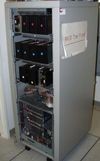1988: U.C. Berkeley paper catalyses interest in RAID
Redundant Arrays of Independent Disks outperform mainframe drives




David Patterson, Garth Gibson, and Randy Katz of U.C. Berkeley presented the paper "A Case for Redundant Arrays of Inexpensive Disks (RAID)" in 1988 claiming that an array of multiple inexpensive disks intended for PC applications could outperform single, large expensive mainframe drives. The concept of mirroring was already well known and some storage systems had already been constructed around arrays of small disks, however their acronym (later changed to Redundant Array of Independent Disks) catalyzed interest in the approach and attracted commercial suppliers.
Pioneering work that led to RAID includes disk-mirrored storage by Tandem Computers in its Non-Stop Architecture and subsystem-mirrored RA8X disk drives (now known as RAID Level 1) by DEC in its HSC50 and HSC 70 systems in the early 1980s. Thinking Machines' DataVault used error-correction codes (RAID 2) in an array of disk drives. The IBM 353 drive used a similar approach in the early 1960s. Patent applications by IBM engineers, Norman Ken Ouchi (1977) and Brian Clark et. al. (1988) disclosed techniques employed in subsequent versions of RAID. Early independent RAID vendors include Adaptec and Array Technology that was founded in 1987 and acquired successively by Seagate, Tandem, and EMC.
A number of standard schemes, called levels, each with many variations, have evolved. RAID levels and their associated data formats are standardized by the Storage Networking Industry Association (SNIA) in the Common RAID Disk Drive Format (DDF) standard. Today, most server-and networked-based storage is based on RAID, and many PC users employ hardware or software RAID systems on their own machines.
Contemporary Documents
- Ouchi, N. K. "System for Recovering Data Stored in Failed Memory Unit" U.S. Patent 4092732 (Filed: May 31, 1977 Issued: May 30, 1978)
- Clark B. E., et al. "Parity Spreading to Enhance Storage Access" U.S. Patent 4761785* (Filed: Jun 12, 1986 Issued: Aug 2, 1988)
- Patterson, D., G. Gibson, R. H. Katz. “A Case for Redundant Arrays of Inexpensive Disks (RAID)” Proc. 1988 ACM SIGMOD Intl. Conf. on Management of Data (1988) (Retrieved on 4.21.15 from: http://www.eecs.berkeley.edu/Pubs/TechRpts/1987/CSD-87-391.pdf)
More Information
- Chen, Peter M., Edward K. Lee, Garth A. Gibson, Randy H. Katz, David A. Patterson. “RAID: High-Performance, Reliable Secondary Storage” ACM Computing Surveys 26 (1994) pp. 145–185.
- Katz, Randy. “RAID: A Personal Recollection of How Storage Became a System” IEEE Annals of the History of Computing, (Vol: 32, No: 4, October-December 2010) pp. 82-86 (Retrieved on 4.21.15 from: http://web.eecs.umich.edu/~michjc/eecs584/Papers/katz-2010.pdf)
- Common RAID Disk Drive Format (DDF) Specification, Storage Networking Industry Association
Oral Histories
- "Gordon, Dave oral history" Computer History Museum Oral History # 102658217 (2008-01-31)
- "Patterson, Dave (David) oral history" Computer History Museum Oral History # 102658154 (2007-09-13)
- “Egan, Dick (Richard) oral history” Computer History Museum Oral History # 102701999 (date)
1988_RAID_v3
Rev: 9.19.18


